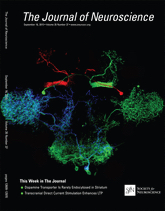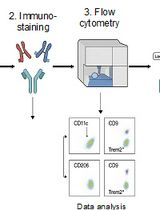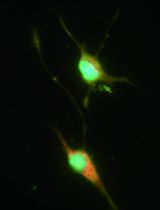- EN - English
- CN - 中文
Isolating Taste Buds and Taste Cells from Vallate Papillae of C57BL/6J Mice for Detecting Transmitter Secretion
从C57BL/6J小鼠轮廓乳头中分离味蕾和味觉细胞以检测递质分泌
发布: 2016年06月05日第6卷第11期 DOI: 10.21769/BioProtoc.1824 浏览次数: 9275
评审: Soyun KimRenate WeizbauerGeoff Lau
Abstract
Mouse is a well-accepted model for studying taste bud function. Mice readily detect and respond to taste substances that humans consider to have sweet, bitter, salty, sour and umami taste qualities. A great deal of recent research on taste receptors is based on this species. Live mice are needed for these experiments because no alternative in vitro model incorporates all elements of taste transduction and peripheral signaling. The C57BL/6J strain was selected because these mice respond robustly to many taste stimuli and because of variety of transgenic animals, such as PLCβ2-GFP and GAD67-GFP, were derived from that strain. Prior analyses on behavior, nerve responses, cellular electrophysiology and molecular biology, all conducted on C57BL/6J mice will form a solid foundation for the proposed studies (Finger et al., 2005; Huang and Wu, 2015; Huang et al., 2007). Thus, freshly euthanized animals must be used as a source of taste buds from which we will isolate taste buds and taste cells.
Keywords: Taste bud (键芽)Materials and Reagents
- Fire-polished borosilicate glass micropipette (World Precision Instrument) with suction apparatus (Figure 1D)
- Polyethylene tubing (BD, Intramedic™, model: PE#205 )
- 1 ml syringe (BD)
Caution: Pipette tip must be large enough to allow taste buds to easily pass through the opening (60~80 µm and 20~30 µm for taste buds and taste cells collection, respectively). However, a wide opening will result in a large volume of solution being drawn into the suction pipette.
- Polyethylene tubing (BD, Intramedic™, model: PE#205 )
- Sylgard dish with dissecting pins (Figure 2A)
- Eppendorf centrifuge tubes (1.5 ml)
- 35 mm culture dishes (Corning)
- Plastic two-way valve of syringes (Figure 1D)
- Cell-TAK cell and tissue adhesive (Corning) coated coverslip(s)
Caution: Apply a tiny drop of Cell-TAK onto the center of 12-mm coverslips. Wait until the droplet is completely dry. Use ethanol (75%) followed by nanopure UV water to rinse and clean coverslips. - C57BL/6J strain mice (the Jackson laboratory) (Figure 1A)
- 100% CO2
- Nanopure UV water (Thermo Fisher Scientific)
- Collagenase A (Roche Diagnostics, catalog number: 10103578001 )
- Dispase II (Roche Diagnostics, catalog number: 04942078001 )
- Elastase (Worthington Biochemical Corporation, catalog number: 2292 )
- Trypsin inhibitor (Roche Diagnostics, catalog number: 10109886001 )
- Calcium chloride (CaCl2) (Sigma-Aldrich, catalog number: C5670 )
- HEPES (Sigma-Aldrich, catalog number: H4034 )
- Potassium chloride (KCl) (Sigma-Aldrich, catalog number: P5405 )
- Magnesium chloride (MgCl2) (Sigma-Aldrich, catalog number: M4880 )
- Sodium chloride (NaCl) (Sigma-Aldrich, catalog number: S7653 )
- Sodium bicarbonate (NaHCO3) (Sigma-Aldrich, catalog number: S6297 )
- Sodium pyruvate (Sigma-Aldrich, catalog number: P5280 )
- D-(+)-Glucose (Sigma-Aldrich, catalog number: G7021 )
- BAPTA (EMD Millipore Corporation, Calbiochem, catalog number: 196418 )
- Ethylene glycol-bis(2-aminoethylether)-N, N, N’, N’-tetraacetic acid (EGTA) (Sigma-Aldrich, catalog number: E0396 )
- Enzyme mixture (see Recipes)
- Tyrode’s buffer (see Recipes)
- Ca2+/Mg2+-free Tyrode’s buffer (see Recipes)
Equipment
- Olympus IX73 inverted fluorescence microscope (Olympus Imaging America Inc., Olympus Optical)
- Stereo dissecting microscope (ZEISS, ZEISS Optical) (Figure 1C)
- Fiber optical illuminator (Dolan-Jenner Industrial Inc.)
- Compressed CO2 gas in the cylinder (Figure 1B)
- Plastic chamber connecting with an ample length of vinyl tubing
- XSE analytical balance (Mettler-Toledo International Inc.)
- Single-sample micro osmometer (Advanced Instruments, model: 3320 )
- Thermo Scientific benchtop pH meter (Thermo Fisher Scientific, Accumet™, model: XL15 )
- Narishige microforge for fire polishing with tungsten filament, electrically heated (NARISHIGE Group, model: MF-900 )
- Flaming/Brown glass micropipette puller (Sutter Instruments, model: P-1000 )
- Recording/Perfusion chamber (Warner Instruments, model: RC-25 ) (Figure 2B)
- Magnetic platform (PH4) for RC-25 recording chamber, and for mounting onto an Olympus IX73 microscope (Figure 2B)
- Thermolyne stirrer (Thomas Scientific, model: Nuova II )
- Spectrafuge 7M microcentrifuge (ReGen Lab Equipment, model: SKU: W095074 )
- Eppendorf 5702 centrifuge (Thermo Fisher Scientific, Fisher ScientificTM, model: Eppendorf 5702 )
- VWR vortex mixer for vortexing the enzyme mix (VWR International, model: MINI 230V )
- Gilson pipettors (200 μl and 1 ml tips) (VWR International)
- Sharp tweezers
- Microsurgical scissors
Procedure
文章信息
版权信息
© 2016 The Authors; exclusive licensee Bio-protocol LLC.
如何引用
Readers should cite both the Bio-protocol article and the original research article where this protocol was used:
- Huang, A. Y. and Wu, S. Y. (2016). Isolating Taste Buds and Taste Cells from Vallate Papillae of C57BL/6J Mice for Detecting Transmitter Secretion. Bio-protocol 6(11): e1824. DOI: 10.21769/BioProtoc.1824.
-
Huang, A. Y. and Wu, S. Y. (2015). Calcitonin gene-related peptide reduces taste-evoked ATP secretion from mouse taste buds. J Neurosci 35(37): 12714-12724.
分类
细胞生物学 > 细胞分离和培养 > 细胞分离
您对这篇实验方法有问题吗?
在此处发布您的问题,我们将邀请本文作者来回答。同时,我们会将您的问题发布到Bio-protocol Exchange,以便寻求社区成员的帮助。
Share
Bluesky
X
Copy link













